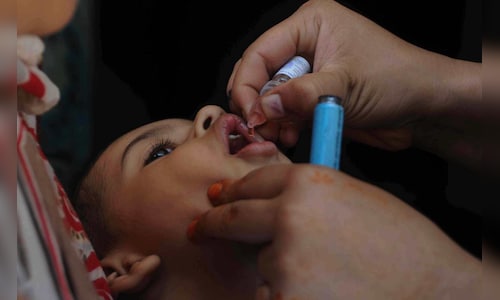Meghalaya Polio Case: Vaccine-induced polio under spotlight after a suspected case detected – CNBC TV18
The World Health Organization (WHO) is investigating a case of poliomyelitis (polio) detected in a two-year-old child from Meghalaya’s Tikrikilla which is situated in West Garo Hills district.
The case, detected nearly two weeks ago, has put state officials on high alert while Union Health Ministry officials have identified it as a case of vaccine-derived polio.
What is polio?
Poliomyelitis or polio is a highly infectious disease caused by poliovirus. The virus targets the nervous system and usually affects children below the age of five years.
However, an unvaccinated person, of any age group, can contract this disease. It is transmitted person-to-person via the faecal-oral route via water or food that has been contaminated.
Symptoms of the infection initially include fever, fatigue, vomiting, headache, pain in the legs and stiff neck.
As per WHO, one in every 200 infections, report irreversible paralysis, usually of the legs. Severe cases can also cause death.
The naturally occurring virus, known as wild-type poliovirus, has been eliminated in most countries and cases caused by it have reduced by 99% since 1988.
As of 2022, endemic wild poliovirus remains in Pakistan and Afghanistan.
India was declared polio-free in 2014 and has since not reported any cases caused by wild poliovirus. The last such case was reported in West Bengal’s Howrah in 2011.
While there is no cure for this disease, it can be prevented by vaccination.
Understanding polio vaccines
Two types of vaccines can be used to tackle poliovirus: oral polio vaccine (OPV) and inactivated polio vaccine (IPV).
As the name suggests, OPV is administered via mouth and contains the live weakened form of the virus. IPV is administered via syringe and contains killed strains of the virus.
OPV is effective against two types of poliovirus, while IPV is effective against all three serotypes of poliovirus. Once administered, the body produces antibodies against the dead/inactivated virus.
“Vaccines mimic the pathogen. That is how we train our immune system so it’s ready the next time there is infection,” says Dr Rakesh Mishra, Director at Tata Institute for Genetics and Society.
UNICEF guidelines recommend administering OPV at birth, 6, 10, and 14 weeks, with a booster at 16-24 months, while IPV should be given at 6 and 14 weeks.
But how can a vaccine cause polio?
While anti-polio vaccines are considered safe, in rare cases weakened viruses in the OPV mutate and lead to vaccine-derived poliovirus.
Dr Mishra explains, “The most common polio vaccine in India is the oral kind. This vaccine contains a weak attenuated virus, meaning it’s alive but weak. It is now known that this virus can replicate and if this is given to a child with weak immunity, the virus can stay in the body for much longer time and can replicate for several months. When the virus replicates, it mutates and that’s how new variants appear.”
Dr Mishra further explained that this condition is extremely rare and can take a very long time, between weeks to months, because the virus is slowly replicating and mutating.
This is a concern in areas with low immunisation rates. The weakened live virus in the OPV can circulate longer among unvaccinated or partially vaccinated populations. Over time, this virus can mutate into a form that regains the ability to cause paralysis, similar to the wild poliovirus.
Risk factors for this to emerge also include poor sanitation.
Since 2000, around 760 cases of vaccine-derived polio cases have been reported in 21 countries.
India and polio
In the 1990s, India accounted for most of the polio cases reported globally, and so, the Pulse Polio Immunisation Programme was launched in 1995 with an ambitious target of 100% coverage.
Policymakers, healthcare workers, and community workers collaborated to ensure every child under five was vaccinated, regardless of previous vaccination status, and maintained surveillance leading to a significant drop in cases.
This helped India achieve polio-free status by 2014.
This drive is still active as a preventive measure and is now part of the National Health Mission. Under this, National Immunisation Days (NIDs) are conducted regularly to administer oral polio vaccines to children under five.
Although administering oral vaccines is easier in mass immunisation drives like the one India was running there is now an ongoing debate over the use of oral polio vaccines.
Dr Mishra believes that since cases of polio from the wild virus have been eradicated, India can consider switching to IPV.
“OPVs keep the virus in circulation. Considering the associated risk, although very rare, we may stop using the oral vaccine and continue using the intravenous one if necessary.”
Images are for reference only.Images and contents gathered automatic from google or 3rd party sources.All rights on the images and contents are with their legal original owners.


Comments are closed, but trackbacks and pingbacks are open.